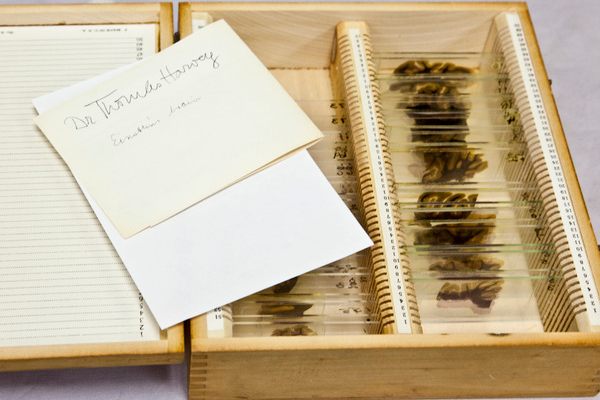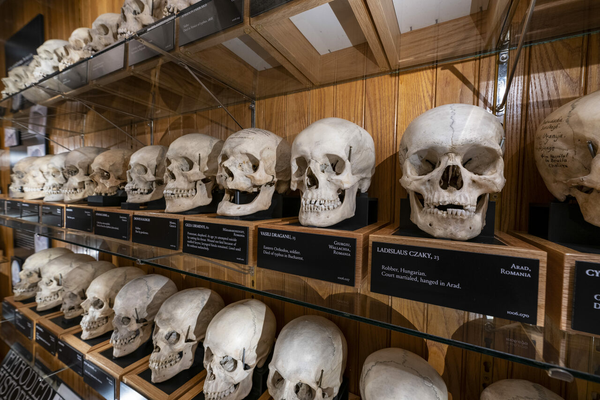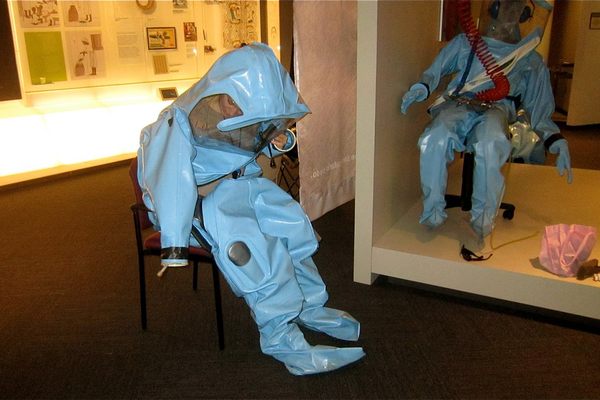The Fates of Famous Brains
Human brains are notoriously difficult to preserve. They’re watery and slippery, and have been likened to the insides of a watermelon. But after the process of preserving them for study was perfected in the mid-19th century, scientists began to seriously collect and study brains, searching for clues about what makes humans work the way they do. Below, the fates of four famous brains, and our attempts to find meaning in them.
Vladimir Lenin (image from Library of Congress)
Lenin
The precise cause of Lenin’s death is still being debated, but the doctors who sliced open his brain during his autopsy found severely hardened arteries that contributed to a massive stroke (when knocked with metal tweezers, the arteries in his brain reportedly “sounded like stone”). Soviet officials, primarily Stalin, had other diagnostic plans for the brain—they wanted scientists to study it to ”prove” Lenin’s genius.

The brain lingered in a glass jar of formaldehyde at the V.I. Lenin Institute for two years while the right experts were found. In 1926, officials finally proposed turning the brain over to pioneering German neurologist Oskar Vogt at the Kaiser Wilhem Institute of Berlin. Vogt was seen as the world’s leading expert on brain anatomy, but he was also a foreigner, and so he was allowed to take only a single sample back to Berlin. The rest of Lenin’s brain remained in Moscow at a newly-created Institute of the Brain, which also began collecting, slicing, and dicing the brains of other Soviet notables.
Vogt travelled back and forth between Moscow and Berlin to study the brain, but his foreignness continued to be a problem. The Soviets made repeated attacks on his creditability, especially when he went so far as to give public lectures comparing Lenin’s brain with those of criminals. Internal memos recommended sending some comrades to Berlin to retrieve the lone specimen at Kaiser Wilhem Institute, but before the Soviets could act, Hitler had dismissed Vogt from his post.
It’s not immediately clear what happened to the brain sample in Berlin, but study on the rest of Lenin’s brain continued at the Moscow Brain Institute for decades. Most of it was kept under wraps until 1993, when the institute’s director, Oleg Adrianov, published the first public account of the brain in Successes in Physiological Sciences, the journal of the Russian Academy of Medical Sciences. Adrianov failed to find anything earth-shattering, and told the UK’s Independent, “‘Cognitive activity, even less behaviour, does not directly relate to brain morphology.”
Lenin’s brain is still kept, in thousands of sliced and dyed sections, at the Moscow Brain Institute, alongside the brains of Stalin, Tchaikovsky, and many other Soviet luminaries, as well as those of monkeys, bears, lizards, and swans. At one point the brain went on display at Lenin’s Mausoleum, where the rest of Lenin’s body can be seen on waxy display in the middle of Moscow.
Image of Einstein’s Brain courtesy of the Mutter Museum, used with permission.
Einstein
Einstein never wanted to be worshipped for his discoveries. He disliked all the personal attention he received, and the whole “cult of individuals” that singled out certain people for veneration because of their accomplishments. “I want to be cremated so people don’t come to worship at my bones,” he told friend and biographer Abraham Pais. His wishes were carried out, but there was one organ that escaped the crematorium’s ovens—his brain.
The pathologist who performed Einstein’s autopsy, Dr. Thomas Harvey, snipped out Einstein’s brain for study, preserving it in formaldehyde, slicing into more than a thousand cross-sections, and encasing it in a plastic-like substance called celloidin.
Harvey has often been portrayed as a common thief, but it’s worth noting that at the time (the 1950s), pathologists routinely kept interesting organs and other specimens from the dead for study. Einstein’s family pitched a fit when they heard the news, but Harvey managed to convince them to let him keep the brain as long as it was used only for scientific analysis. It took decades for studies on the brain to start appearing—Harvey initially had trouble letting the brain out of his sight—but in recent decades there has been a trickle of papers attempting to find the source of Einstein’s genius rooted somewhere in the structure of his brain. The results are controversial, in part because of the chicken-and-egg question: Was Einstein so smart because of the way his brain was shaped, or did his brain change shape as a result of his thinking? The other problem is the lack of samples to which Einstein can be compared; with the brain being the most complex and unique organ in the body, it’s impossible to generalize from a single case.
In 1998, Harvey returned what was left of the brain to Princeton Hospital, where Einstein’s initial autopsy was conducted. And in late 2011, forty-six slides slides of the brain went on display at the Mütter Museum of the College of Physicians of Philadelphia, donated by neuropathologist Lucy Rorke-Adams, whose colleague had been given the slides by Harvey decades earlier.
Mussolini (image from State Library of New South Wales)
Mussolini
After Mussolini was captured and executed in the closing days of World War II, both Italian and American doctors wanted a look inside his skull. His brain was reportedly sent to the Institute of Legal Medicine in Milan, and Mussolini’s widow Rachele described seeing it there in 1946, stored in a chalice-shaped glass jar and labeled with a false name. She was encouraged to take it home, but told the authorities that she had nowhere to put it. The brain was returned to her in 1957, alongside the rest of Mussolini’s body, but was not entirely intact.
According to documents in Italian archives, a psychiatric consultant working with the US Fifth Army after World War II wrote to Italy’s National Liberation Committee requesting a small specimen of Mussolini’s brain “as a great favor.” The request was granted, and the specimen was studied by pathologists at the Army Medical Museum in Washington DC. At the time, some scientists believed Mussolini was suffering from general paresis—brain syphilis—but the sample proved far too small and battered to prove or disprove that theory. It reportedly remained in a jar of alcohol at the Army Medical Museum, later renamed the U.S. Armed Forces Institute of Pathology, for the next twenty years.
In 1966, Mussolini’s widow wrote to the U.S. ambassador in Italy requesting the return of the brain fragment. It was not immediately clear where it was, but after some searching, US officials located it at the institute and shipped it back to Mussolini’s family via diplomatic pouch. It arrived in a yellow-orange envelope marked, “Musolinni [sic], fragments of brain.”
Other fragments of the brain, and some of Mussolini’s blood, also went up for sale on eBay in 2009. The listing was removed before within hours, before anyone bid. (eBay forbids sellers from listing most human remains.)
Walt Whitman in 1887 (photo from Wikipedia)
Whitman
Walt Whitman was fascinated by anatomy and physiology, as well as phrenology. After having his skull read at the Fowler and Wells Phrenological Cabinet in New York City in 1849, he was so enamored of the results that he had his chart reprinted in some editions of Leaves of Grass. Several of his physicians were more interested in brains than skulls, however, and belonged to the American Anthropometric Society (aka “the Brain Society”), a group of eminent medical men in Philadelphia who were devoted to advancing brain science by donating their own grey matter for study. (There were hundreds of such brain donation societies around the world; the first, in France in 1876, was the Societe Mutuelle d’ Autopsie, or The Society of Mutual Autopsy.)
Whitman may or may not have been a member of the American Anthropometric Society himself, but after his death in 1892, several of his physicians felt justified in removing his brain for study. In 1907, the Philadelphia North American prompted a minor panic by reporting that the brain had been somehow destroyed. The official version is that a clumsy lab assistant dropped it, although there other reports that it was damaged either during the autopsy, while being conveyed to the specimen jar, or during the preservation process. However, the writer and mathematics professor Brian Burrell maintains some hope of the “possibility, however remote, that the brain will show up some day in a dusty attic or dank cellar vault.”


















Follow us on Twitter to get the latest on the world's hidden wonders.
Like us on Facebook to get the latest on the world's hidden wonders.
Follow us on Twitter Like us on Facebook